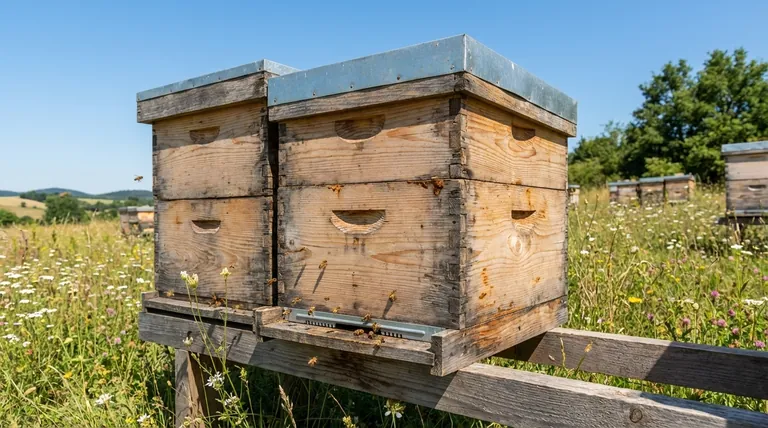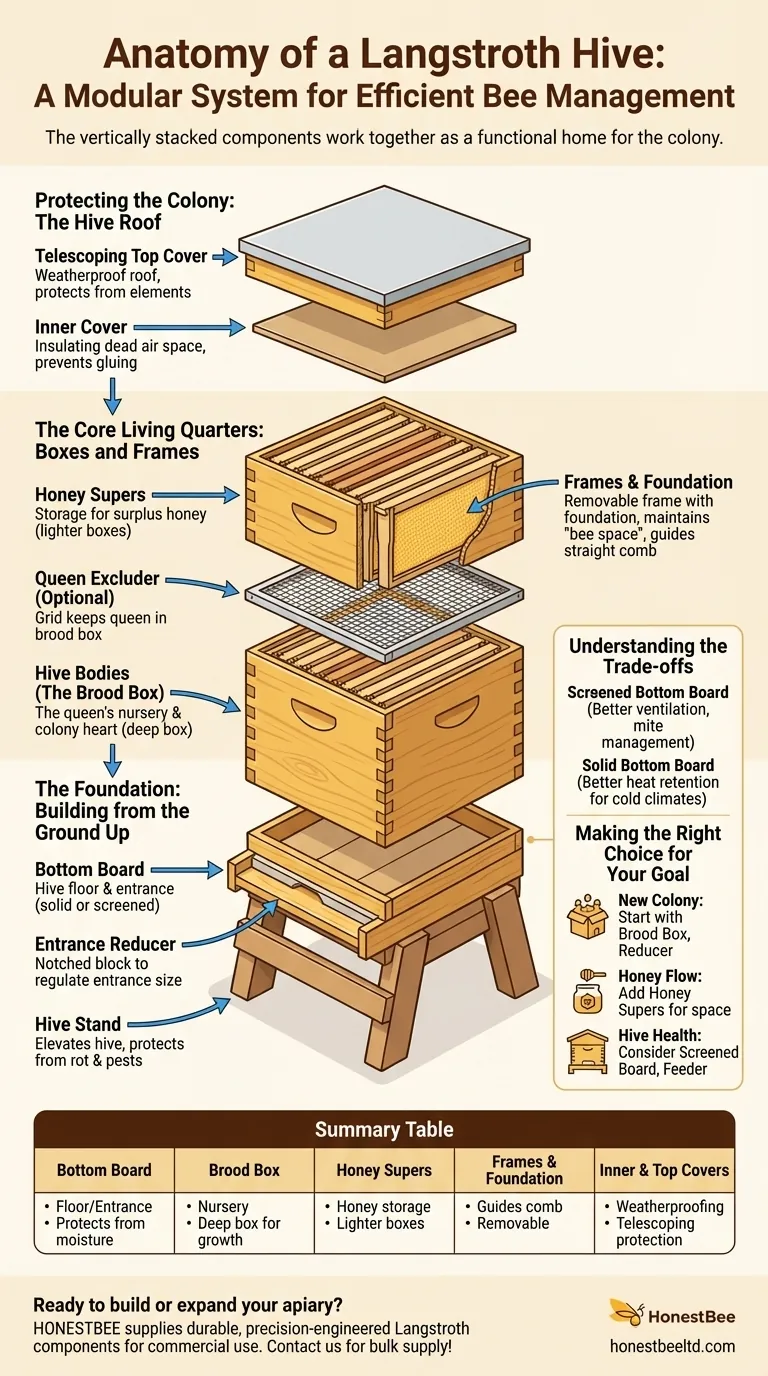A Langstroth hive is a modular system designed for efficient bee management. The essential components, stacked vertically, are a bottom board, one or more hive boxes (called "supers") filled with frames, an inner cover, and a telescoping top cover. These core parts create a functional home for the colony and allow beekeepers easy access for inspection and honey harvesting.
The key to understanding the Langstroth hive isn't just memorizing the parts, but seeing how they work together as a vertically stacked "bee apartment building." Each component serves a specific function for both the bees' survival and the beekeeper's management.

The Foundation: Building from the Ground Up
The base of the hive provides stability, an entrance for the bees, and protection from the ground. It's the first section you will place.
The Hive Stand
A hive stand is a simple but critical component that elevates the entire hive off the ground. This elevation protects the wooden bottom board from rot, improves air circulation, and makes it harder for pests like ants to gain access.
The Bottom Board
This is the floor of the beehive. It has raised sides that form the hive's main entrance. Bottom boards come in two main types: solid and screened, each offering different benefits for ventilation and pest management.
The Entrance Reducer
An entrance reducer is a small, notched block of wood placed at the hive entrance. It shrinks the opening, which helps a new or small colony defend itself against robber bees and regulate its internal temperature more easily.
The Core Living Quarters: Boxes and Frames
This middle section is where the colony lives, raises its young, and stores the majority of its food. It is the most active part of the hive.
Hive Bodies (The Brood Box)
The bottom-most box is the brood box or hive body. This is the heart of the colony, where the queen lays her eggs and the colony raises its young (the brood). These are typically "deep" boxes to provide ample space for the queen's nursery.
Honey Supers
Any box placed above the brood box is called a honey super. This is where bees will store their surplus honey. Beekeepers often use "medium" or "shallow" supers because they are significantly lighter and easier to lift when full of honey.
Frames and Foundation
Inside each box hang removable frames. This is the single most important innovation of the Langstroth hive. The precise spacing between frames—the "bee space"—allows bees to work while enabling the beekeeper to remove and inspect each frame without destroying the comb. Most frames hold a sheet of foundation (wax or plastic) to guide the bees in building straight, orderly honeycomb.
Protecting the Colony: The Hive Roof
The top section of the hive seals the colony from the elements, providing insulation and protection from rain, sun, and wind.
The Inner Cover
The inner cover sits directly on top of the uppermost super. It provides an insulating dead air space and often has a small notch that can be used as an upper entrance or for ventilation. It prevents the bees from gluing the top cover down with propolis.
The Telescoping Top Cover
This is the final, weatherproof roof of the hive. It's called "telescoping" because its sides extend down over the top super, protecting the hive joints from rain. These covers are typically sheathed in metal for long-term durability against the elements.
Understanding the Trade-offs
While the core components are standard, several optional parts involve a strategic choice based on your management style and climate.
The Queen Excluder
A queen excluder is a flat grid of wire or plastic placed between the brood box and the honey supers. The slots are large enough for worker bees to pass through but too small for the larger queen. This ensures the honey supers remain free of eggs and brood. The trade-off is that some beekeepers believe it can slightly hinder worker movement and reduce honey production.
Screened vs. Solid Bottom Boards
A screened bottom board improves ventilation, which is crucial in hot climates, and helps with managing Varroa mites, as the mites can fall through the screen. A solid bottom board, however, offers better heat retention, which can be an advantage for colonies in colder climates.
Making the Right Choice for Your Goal
Your initial hive setup and subsequent additions will depend on the colony's needs at each stage of its development.
- If your primary focus is starting a new colony: Begin with a single brood box, a bottom board, frames, inner/outer covers, and an entrance reducer to help the small colony establish itself securely.
- If your primary focus is preparing for a honey flow: Your priority is adding one or more honey supers above the brood box to give the bees ample space for surplus honey storage.
- If your primary focus is managing hive health: Consider a screened bottom board for integrated pest management and have a hive feeder on hand to provide nutritional support if natural nectar is scarce.
Understanding how these components function together is the first step toward becoming a confident and successful beekeeper.
Summary Table:
| Component | Primary Function | Key Feature |
|---|---|---|
| Bottom Board | Hive floor and entrance | Protects from ground moisture, comes in solid/screened types |
| Brood Box | Queen's nursery for egg-laying and brood-rearing | Deep box for colony growth and development |
| Honey Supers | Storage for surplus honey | Lighter medium/shallow boxes for easy honey harvesting |
| Frames & Foundation | Guides bees to build straight honeycomb | Removable for inspection, maintains 'bee space' |
| Inner & Top Covers | Weatherproofing and insulation | Telescoping cover protects hive from rain and elements |
Ready to build or expand your apiary with professional-grade equipment? HONESTBEE supplies durable, precision-engineered Langstroth hive components to commercial apiaries and beekeeping equipment distributors. Our wholesale-focused operations ensure you get reliable, scalable solutions for hive management and honey production. Contact us today to discuss your bulk supply needs and elevate your beekeeping operation!
Visual Guide

Related Products
- Langstroth Bee Hives Bee Keeping Box for Beginners Beekeeping
- HONESTBEE Advanced Ergonomic Stainless Steel Hive Tool for Beekeeping
- Long Langstroth Style Horizontal Top Bar Hive for Wholesale
- Ergonomic Two Person Foldable Hive Lifter
- Professional Galvanized Hive Strap with Secure Locking Buckle for Beekeeping
People Also Ask
- What basic equipment is needed to start beekeeping? Your Essential Guide to a Confident Start
- Should a beginner try a different type of hive? Start with a Langstroth for a solid foundation.
- What are the different types of beehive boxes available? Choose the Right Hive for Your Apiary
- What are the key features of the Langstroth beehive? A Guide to the Standard for Modern Beekeeping
- Why are Langstroth hives recommended for beginners? Unmatched Support & Standardization



















